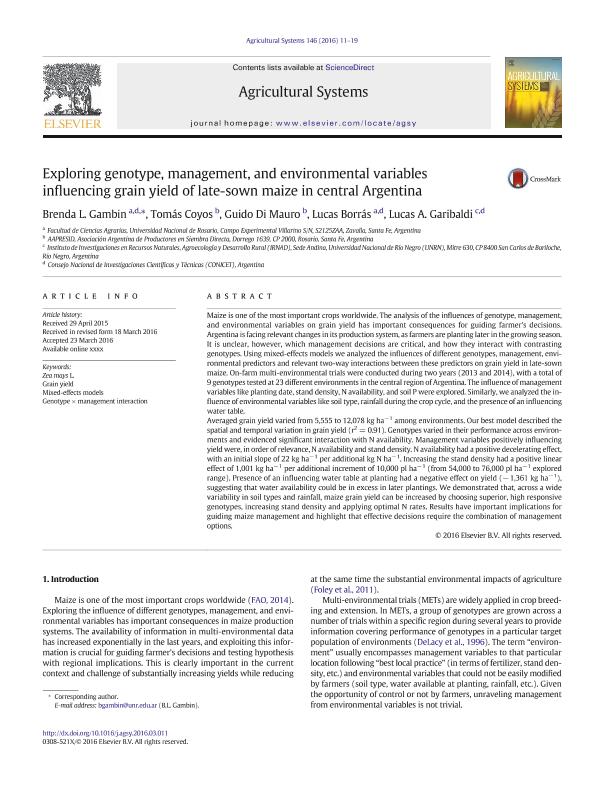Artículo
Exploring genotype, management, and environmental variables influencing grain yield of late-sown maize in central Argentina
Fecha de publicación:
07/2016
Editorial:
Elsevier
Revista:
Agricultural Systems
ISSN:
0308-521X
Idioma:
Inglés
Tipo de recurso:
Artículo publicado
Clasificación temática:
Resumen
Maize is one of the most important crops worldwide. The analysis of the influences of genotype, management, and environmental variables on grain yield has important consequences for guiding farmer´s decisions. Argentina is facing relevant changes in its production system, as farmers are planting later in the growing season. It is unclear, however, which management decisions are critical, and how they interact with contrasting genotypes. Using mixed-effects models we analyzed the influences of different genotypes, management, environmental predictors and relevant two-way interactions between these predictors on grain yield in late-sown maize. On-farm multi-environmental trials were conducted during two years (2013 and 2014), with a total of 9 genotypes tested at 23 different environments in the central region of Argentina. The influence of management variables like planting date, stand density, N availability, and soil P were explored. Similarly, we analyzed the influence of environmental variables like soil type, rainfall during the crop cycle, and the presence of an influencing water table. Averaged grain yield varied from 5,555 to 12,078 kg ha-1 among environments. Our best model described the spatial and temporal variation in grain yield (r2 = 0.91). Genotypes varied in their performance across environments and evidenced significant interaction with N availability. Management variables positively influencing yield were, in order of relevance, N availability and stand density. N availability had a positive decelerating effect, with an initial slope of 22 kg ha-1 per additional kg N ha-1. Increasing the stand density had a positive linear effect of 1,001 kg ha-1 per additional increment of 10,000 pl ha-1 (from 54,000 to 76,000 pl ha-1 explored range). Presence of an influencing water table at planting had a negative effect on yield (-1,361 kg ha-1), suggesting that water availability could be in excess in later plantings. We demonstrated that, across a wide variability in soil types and rainfall, maize grain yield can be increased by choosing superior, high responsive genotypes, increasing stand density and applying optimal N rates. Results have important implications for guiding maize management and highlight that effective decisions require the combination of management options.
Archivos asociados
Licencia
Identificadores
Colecciones
Articulos(CCT - PATAGONIA NORTE)
Articulos de CTRO.CIENTIFICO TECNOL.CONICET - PATAGONIA NORTE
Articulos de CTRO.CIENTIFICO TECNOL.CONICET - PATAGONIA NORTE
Articulos(CCT - ROSARIO)
Articulos de CTRO.CIENTIFICO TECNOL.CONICET - ROSARIO
Articulos de CTRO.CIENTIFICO TECNOL.CONICET - ROSARIO
Articulos(IICAR)
Articulos de INST. DE INVESTIGACIONES EN CIENCIAS AGRARIAS DE ROSARIO
Articulos de INST. DE INVESTIGACIONES EN CIENCIAS AGRARIAS DE ROSARIO
Citación
Gambin, Brenda Laura; Coyos, Tomás; Di Mauro, Guido; Borras, Lucas; Garibaldi, Lucas Alejandro; Exploring genotype, management, and environmental variables influencing grain yield of late-sown maize in central Argentina; Elsevier; Agricultural Systems; 146; 7-2016; 11-19
Compartir
Altmétricas




